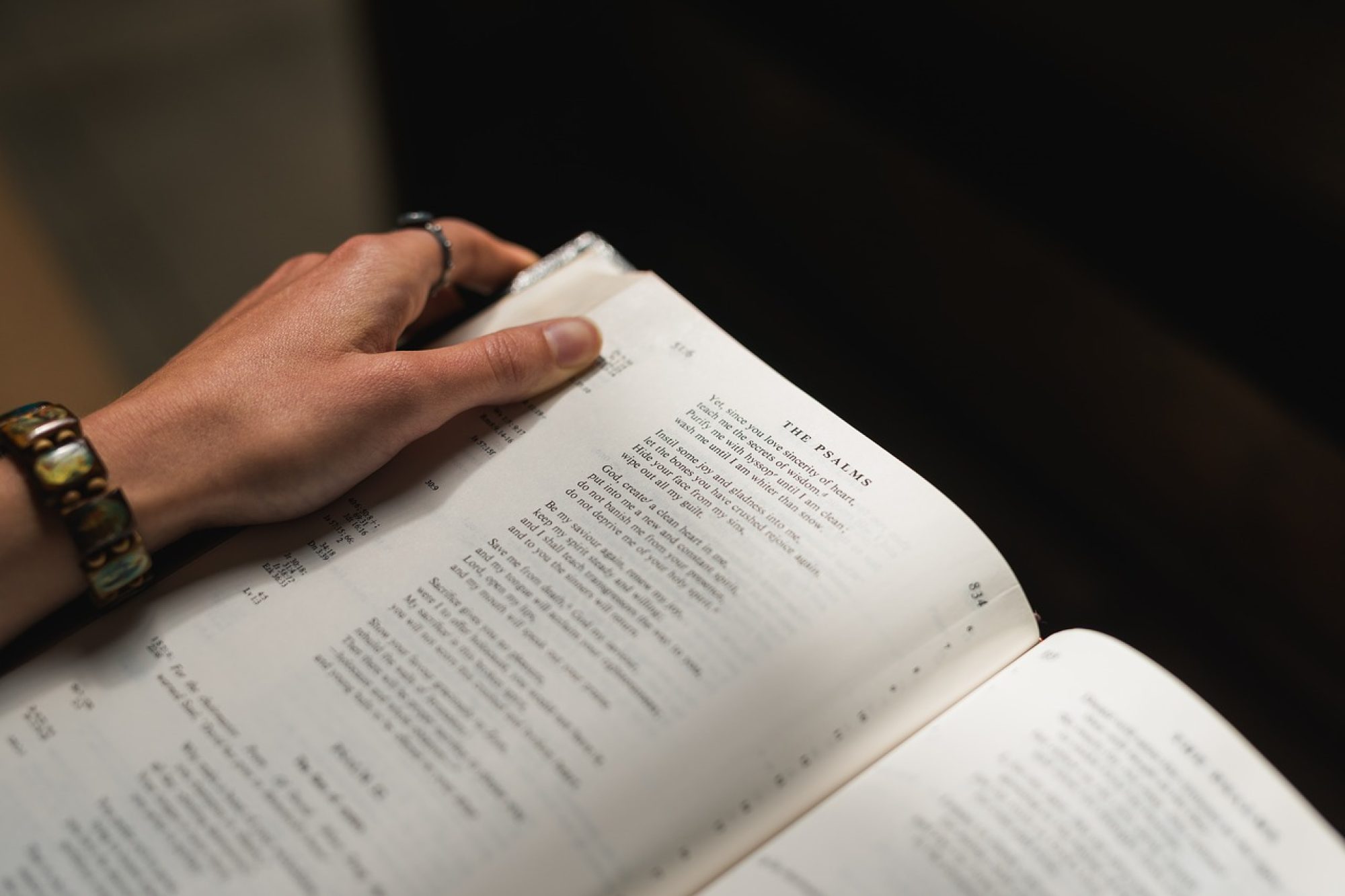
Het delen van brood en wijn enkel voor gedoopte broeders en zusters
Na de doopdienst kreeg ik een vraag van een jonge dame die bedroefd was omdat zij en anderen toch gedoopten niet mochten delen in het brood en de wijn.
Met die andere gedoopten bedoelde zij Katholieken. Ik trachtte haar duidelijk te maken dat er twee belangrijke redenen waren.
Kinderdoop

In het katholieke geloof worden de meesten als baby gedoopt. Die kinderdoop wordt meestal in de eerste dagen of weken van het leven van een kind toegediend waarbij men er van uit gaat dat die begieting met wat water volgens de kerkvader Augustinus de erfzonde zou afwassen. Hierbij gaat men er vanuit dat volgens de leer van de Rooms-Katholieke kerk zo de babies kunnen beveiligd worden, wanneer ze vroegtijdig zouden overlijden, dat ze niet gedoemd zouden zijn om voor eeuwig in de hel te moeten branden. De (kinder)doop betekent zo (volgens de Katholieke leer) dat men het heil ontvangt en wordt ingelijfd bij de kerk.
In het verleden ging die Paapse Kerk zo ver dat in de tijd van de vervolging en inquisitie men moest kieze voor ofwel de dood ofwel de doop.

Bij de kinderdoop heeft het kind echter nooit zelf de keuze gemaakt voor God, maar hebben de ouders of anderen die keuze voor het kind gemaakt.
Het komt er echter op aan dat eenieder wanneer deze op een leeftijd van bewustzijn is gekomen een bewuste keuze maakt om in Jezus naam een kind van God te willen zijn en hiervoor die richting van het geloof in te gaan.
Volwassenendoop
Op latere leeftijd kan een mens zelf beslissen welke kant deze wil uit gaan.
Bij de eerste christenen ging het altijd om een daad van overgave aan God, welke men pas kon verrichten op een leeftijd van verstand. Katholieken en Reformanten zaten met de doemgedachte van de hel in hun hoofd en wensten het kind hiervoor te behoeden. Als grond voor de kinderdoop wordt door hen gewezen op het verbond en Gods belofte.

In onze contreien kwamen in de tijd van de Reformatie ook meer anabaptisten en baptisten naar voor, die een Enige God predikten en een volwassen doop. De Doperse stroming verwierp de kinderdoop en pleitte voor de doop nadat men een geloofsbelijdenis had afgelegd. In Nederland werd dit gedachtegoed onder meer aangehangen door Menno Simons, een Friese ex-priester, die doopsgezind werd.

De Baptisten noemen hun doopceremonie liever geloofsdoop omdat ook jongeren die nog geen volwassene zijn, maar wel al voldoende inzicht hebben in de Bijbelse Waarheid, op grond van hun geloof gedoopt kunnen worden. Ook bij de Broeders in Christus of Christadelphians gaat men er van uit dat eens een persoon zelf een bewuste keuze kan maken en kan bewijzen voldoende inzicht te hebben in Gods Woord en Leer, deze zich kan over geven aan God, door zich te laten onderdompelen in water, als symbolische daad van purificatie of zuivering van vroegere zonden.
Deelname aan de herinnering van het avondmaal
In de meeste kerken van het christelijk geloof kan men slechts ter communie gaan als men de geloofsbelijdenis van die gemeenschap erkend en ondertekend heeft.

In de oosters-orthodoxe kerken en de rooms-katholieke kerk wordt het Laatste Avondmaal herdacht in de eucharistie, waarvan de Heilige Communie een onderdeel is.
In de Latijnse ritus van de katholieke Kerk wordt bij de communie slechts de geconsacreerde hostie uitgereikt, het drinken uit de miskelk is meestal voorbehouden aan de priester. Bij speciale gelegenheden kan het voorkomen dat de gelovigen ook onder twee gedaanten (hostie en wijn uit de kelk) te communie gaan. De gedachte hierbij is dat men één met Christus wordt.
Ook bij de Christadelphians is er een herinnering met een « offermaaltijd » waarbij er brood wordt gebroken en dit als symbool van Jezus lichaam uitgedeeld wordt aan al de gelovigen die volgens de Bijbelse voorwaarden gedoopt zijn, namelijk een volledige onderdompelingen met een getuigenis van het geloof in slechts één God (Jehovah) en in Zijn gezonden heiland, Jezus Christus. De wijn staat dan als symbool voor het vergoten bloed van Christus, dat door de gedoopte gelovigen mag genuttigd worden, als teken van vergeving van zonden door Jezus’ bloed.
Waarom slechts beperkte deelname
Voor christenen uit de Trinitarische geloofsgemeenschappen mag het vreemd zijn dat zij niet mee mogen aanschuiven aan de offerande tafel in de diensten van Christadelphians.
Dit komt omdat de Christus waarin de Christadelphians geloven een andere Christus is dan diegene waarin de Trinitarische Christenen, zoals Katholieken, Anglicanen, Hervormden, e.a. in geloven. Voor diegenen die in de Drie-eenheid geloven is Jezus Christus God die naar de aarde gekomen is om ons te verlossen.
Voor Christadelphians en andere Ware Christenen, zoals Jeshuaisten en leden van Het Abrahamitische geloof, de Kerk van God, Nazareense Vrienden, Getuigen van Jehovah, kan men alleen maar deelgenoot aan de tafel zijn als men behoort onder hen die deel uitmaken van de goedgekeurden door God, of hen die slechts Jehovah als de Enige Ware God aanbidden.
Voor God is er geen tussenweg. Hij aanvaard enkel ware aanbidding.
Indien men toch graag mee aan tafel aansluit
Tijdens de doop ceremonie viel het op dat er verscheidene aanwezigen wel overtuigd waren dat Jezus de zoon van God is. Maar erg genoeg waren ze ervan overtuigd dat hun Katholieke Kerk er daar ook zo over dacht en Jezus niet als God aanschouwden. Ik heb hun aangemoedigd om hun pastoor of enkele priesters van die kerk daar toch vragen over te stellen, zodat ze een beter inzicht zouden krijgen in de leer van de Katholieke Kerk.
Indien zij er werkelijk van overtuigd zijn dat Jezus de zoon van God is en niet een god de zoon, zouden ze zich er best van gewissen of dat ze wel in een juiste geloofsgemeenschap zitten en of het niet beter is om dan ook naar buiten toe en naar God toe, het niet beter zou zijn om zich aan te sluiten bij een kerkgemeenschap die zich houdt aan de Bijbelse leerstellingen?
+
Voorgaande
- Getrouwen aan God laten zich dopen
- Kinderdoop tegenover doop als volwassene #4 Vragen voor de doopkandidaat
- De intenties van onze Brusselse ecclesia
- Heugelijk nieuws op 5 Mei 2024
- Deelnemers zich verenigend tot één lichaam
- Onze eerste doopsels in onze kersverse ecclesia
++
Aanvullende lectuur
- De Enige Ware God
- Geloof in slechts één God
- Heilige Drievuldigheid of Drie-eenheid
- Drie-Eenheid – God de zoon of zoon van God
- Drie-Eenheid of niet
- Jezus Christus in het vlees gekomen
- Zoon van God
- Christus Jezus de zoon van God
- Zoon van God de weg naar God
- Broeders en Zusters in Christus door de eeuwen heen #9 Controverse betreft doop
- Broeders en Zusters in Christus door de eeuwen heen #12 Anabaptisten
- 16° Eeuwse Broeders in Christus
- Door genade van God tot geloof komen
- De roeping van Christus #2
- Geestelijke vorming tot heiligheid #3
- De Taal van de Bijbel: … Punt — streep
- Overtuiging voor de dingen die God beloofde
- Doop en Geloof
- Als men zich wil laten dopen
- Gods vergeten Woord 17 Geleid door de Geest 1 Waterdoop en Vuur
- Gods vergeten Woord 5 Verloren Wetboek 4 De ‘katholieke’ kerk
- Redding, vertrouwen en actie in Jezus #6 Samenhoren
- De Weg tot verlossing
- Dopen en herdopen
- Doopverplichting bij Baptisten
- Wedergeboorte en lidmaatschap tot een kerk
- De Ekklesia #6 Bad der Wedergeboorte
- De Ekklesia #8 Doop als wedergeboorte
- De Ekklesia #9 Daad van geloof
- Zelfverloochening en witwassen door doop
- Synode: Jezus annuleerde Bijbels ‘Gekozen volk’
- Ontdopen gaat verder in België, een keerpunt om stil bij te staan
- De Bekeerling, bekeringsactie en bekering
- Willem J. Ouweneel wil ware volgers van de echte Jezus niet als christenen erkennen
- Pinksterkerken en RKK dichter bij elkaar
- Christadelfiaanse geloofspunten #11 Redding door het evangelie te geloven
- Doop in de huiskerk
- Christadelfiaanse geloofspunten #23 Geloofspunten opgetekend in de Birmingham Amended Statement of Faith
- Oor die afwagting van nuwe doop

